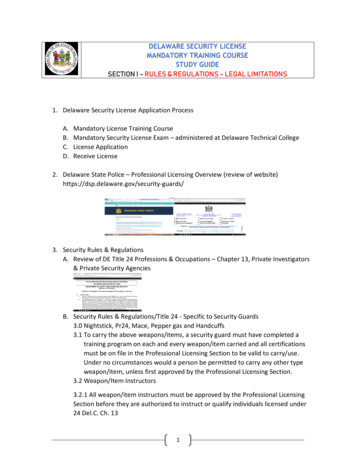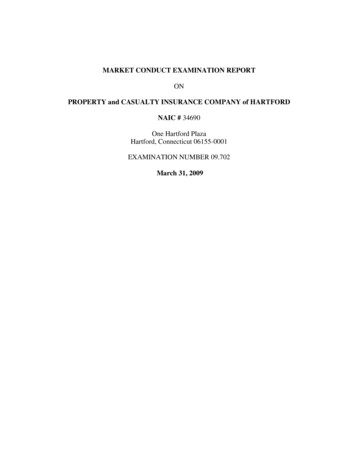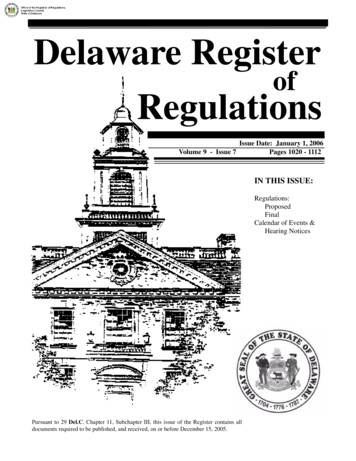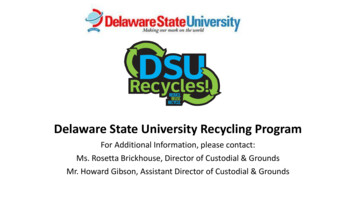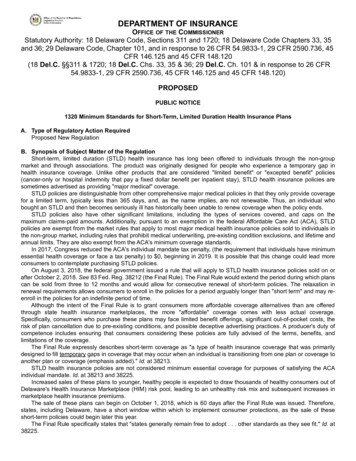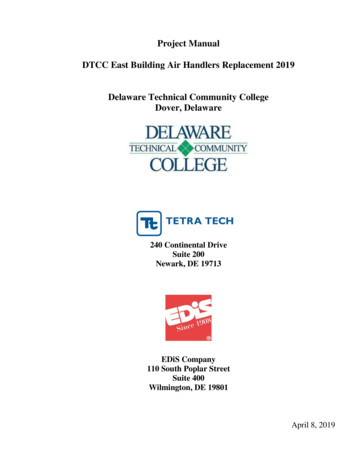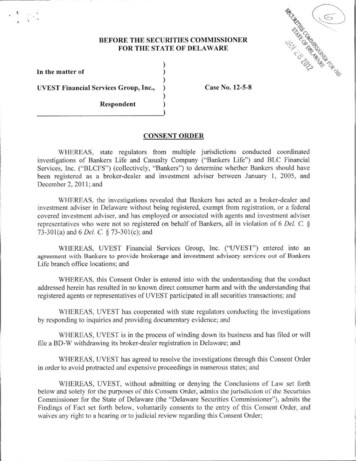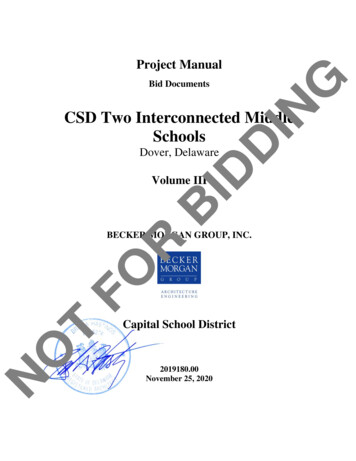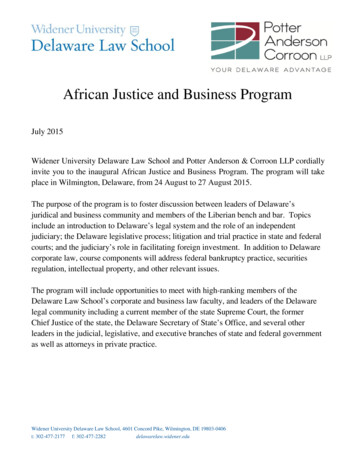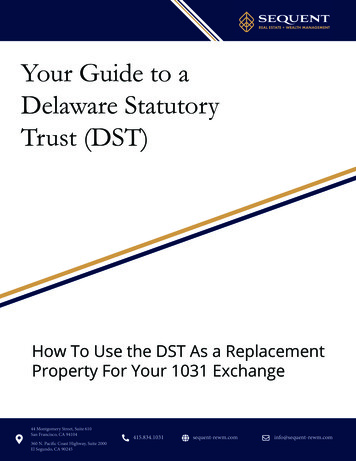
Transcription
Your Guide to aDelaware StatutoryTrust (DST)How To Use the DST As a ReplacementProperty For Your 1031 Exchange44 Montgomery Street, Suite 610San Francisco, CA 94104360 N. Pacific Coast Highway, Suite 2000El Segundo, CA .com
1. What is a Delaware Statutory Trust (DST)?A Delaware statutory trust (DST) permits fractional ownership where multiple investorscan share ownership in a single property or a portfolio of properties, which qualifies asreplacement property as part of an investor’s 1031 exchange transaction. A DST takes alloperational decision-making and active management activities out of the hands of theinvestor and places it into the hands of an experienced sponsor-affiliated trustee.2. Defer Taxes on Capital GainsSection 1031 of the Internal Revenue Code provides an effective strategy for deferringcapital gains tax that may arise from the sale of a business or investment real property.By exchanging the real property for like-kind real estate, real property owners may defertaxes and use the proceeds to purchase replacement property. Like-kind real estateincludes business and investment real property, but not the property owner’s primaryresidence.It is important to note that several specific requirements must be met in order tosuccessfully execute a 1031 exchange transaction. Most importantly, the total purchasevalue of the replacement property must be equal to or greater than the value of therelinquished property sold. Additionally, all the cash proceeds must be used, and thedebt can be replaced with new debt or additional cash. In other words, additional cashcan make up for a shortfall in debt placed on a replacement property, but additionaldebt cannot make up for a shortfall in cash invested in a replacement property.Any “unreplaced” debt or equity would be considered boot and would likely have taxconsequences. Prospective investors should consult their tax advisors regarding a 1031exchange and their specific situation.3. Investors with Property to ExchangeA 1031 exchange involving an investment into a DST typically has three steps:01Exchanger sells property,known as the relinquishedproperty, and proceedsare escrowed with aQualified Intermediary. 02Qualified Intermediary,through a writtenagreement with the investor,transfers funds for purchaseof replacement property 03Exchanger completes theexchange and receivesbeneficial interest in a DST.4. The Role of a Qualified Intermediary (QI/Accomodator)The QI is a company that facilitates Section 1031 tax-deferred exchanges. The QI entersinto a written agreement with the investor where the QI transfers the relinquishedproperty to the buyer, while transferring the replacement property to the investorpursuant to the exchange agreement. The QI holds the proceeds from the sale of therelinquished property in a trust or escrow account in order to ensure the investor neverhas actual or constructive receipt of the sale proceeds, which would trigger capital gainconsequences.
5. 1031 Exchange TimelineClose RelinquishedPropertyIdentify ReplacementPropertyDay 1Day 45Last Day to CloseReplacement PropertyDay 180The time requirements in a 1031 exchange are very specific. From the close of escrow onthe sale of the relinquished property, a taxpayer must properly identify potentialreplacement properties within 45 calendar days and close on the replacementproperties within 180 calendar days.6. Like-Kind Real EstateTo complete a successful Section 1031 tax-deferred exchange, the replacement propertymust be like-kind to the relinquished property. Some examples of like-kind propertiesinclude: Multifamily Apartments Healthcare Self-Storage Facilities Retail Centers Industrial Warehouses Student HousingAny real estate held for productive use in a trade or business or for investment purposesis considered like-kind. A primary residence would not fall into this category, however,vacation homes or rental properties may qualify in some situations.
7. How to Utilize a DST8. Key Benefits of a DSTA DST can solve for different solutions in a 1031exchangeA DST can solve for different solutions in a 1031exchangeFull Replacement of Relinquished Asset ina Timely MannerDSTs are a popular solution that can beused to address the changing nature ofinvestment property owner’s objectives asthey age. A DST investment can be selectedand identified before the close of therelinquished asset, simplifying the 1031exchange process.BootAny leftover equity or debt in a 1031exchange is subject to taxable gain. A DSTcan solve the tax problem for cash boot ormortgage boot.No Management ResponsibilitiesThe DST is the single owner and agile decisionmaker on behalf of investors.Access to Institutional-Quality PropertyMost real estate investors can’t afford toown multi-million dollar properties. DSTs allowinvestors to acquire partialownership in properties that otherwise would beout-of-reach.Limited Personal LiabilityLoans are non-recourse to the investor. The DSTis the sole borrower.Back up - The Pitfalls of Day 45Lower Minimum InvestmentsDon’t get sidelined by Day 45. A DST haslittle close risk as the trust has secured title,and the financing terms are set and closed.A DST can be a backup to a first choice onDay 45 of the identification process.DSTs can accommodate much lower minimuminvestments, whereas 1031 exchange minimumsoften are 100,000.Estate Plan (Swap Until You Drop)Streamline the transfer of real estate wealthwith fractional ownership of a DST. Yourheirs will receive ownership upon death at astep-up in basis.DiversificationInvestors can divide their investment amongmultiple DSTs, which may provide for a morediversified real estateportfolio across geography andproperty types.
9. Risks of Investing in a DST include, but are not limited to:At its core, the DST is a real estate asset. The inherent risks associated with any real estateinvestment should be considered before investing and compared against the available benefits. For example, one should consider property values and operational performance, orthe ability to generate cash flow, and the impact by changing economic, demographic andclimatic conditions. In addition, elements of the DST’s structure and requirements shouldalso be understood and considered in conjunction with an investor’s objectives.Sponsors are Important:The DST sponsor is the entity that creates the DST to hold and manage real property andarrange for issuing beneficial interest to investors. The sponsor locates and acquires the realestate through comprehensive due diligence and secures financing for the trust. Who thesponsor is, their track record, and long term experience can often be one of the most important decisions when selecting the DST.No Liquidity and Potential Losses:The purchase of any DST sponsored program is speculative. It is suitable only for personswho can accept the lack of liquidity and willing to put their entire equity investment at risk.The sponsor company spends a significant amount of time and resources on due diligence,underwriting and analysis when acquiring the properties. However, there is still no guarantee that the investment objectives will be achieved. As an investor, taking the time to reviewthe offering documents and understanding the real estate is an integral part of the process.As a Passive Investment, the Sponsor Maintains Control:With a DST, investors can still enjoy the benefits of owning real estate without dealing withday-to-day landlord activities. The investor is now relying on the sponsor, a professional realestate investment management firm, for all property operations and decisions and does nothave any voting rights. Being willing to give up control and decision making is an importantpart of the DST.The Imbedded Fees:With any investment, there is always a cost. A DST has three major phases- acquisition, operations and disposition. Each phase will incur its economic costs associated with the investment. Costs include management fees, disposition fees and some upfront fees, referred toas “Load.” These load fees can consist of commissions, Broker-Dealer allowances, offering &organization costs, financing fees, etc., which are all capitalized into the DST/Investor transaction. Engaging with a trusted professional to understand each invested dollar’s application ina DST is very important to understand.Specific risk factors are detailed in the Private Placement Memorandum of each DST andshould be reviewed and evaluated.IRC Section 1031 is a complex tax concept, therefore you should consult your legal or taxprofessional regarding the specifics of your particular situation, and understand all associated risks of an offering prior to making an investment.
10. The Seven Deadly Sins1. Once the offering is closed, there can be no future capital contributions to the DSTby either current or new beneficiaries.2. The trustee cannot renegotiate the terms of the existing mortgage loans nor canit obtain any new mortgage financing from any party except where a propertytenant is bankrupt or insolvent.3. The trustee cannot enter into new leases or renegotiate existing leasesexcept where a property tenant is bankrupt or insolvent.4. The trustee cannot reinvest the proceeds from the sale of its real estate.5. The trustee is limited to making the following types of capital expenditures withrespect to the property: (a) expenditures for normal repair andmaintenance of the property, (b) expenditures for minor non-structuralcapital improvements of the property, and (c) expenditures for repairs orimprovements required by law.6. Any cash held between distribution dates can only be invested in short-term debtobligations.7. All cash, other than necessary reserves, must be distributed on a current basis.Disclosures:This is for informational purposes only, does notconstitute as individual investment advice, andshould not be relied upon as tax or legal advice.Please consult the appropriate professional regarding your individual circumstance. Because investorsituations and objectives vary this information isnot intended to indicate suitability for any individualinvestor.DST 1031 properties are only available to accredited investors (typically have a 1 million net worthexcluding primary residence or 200,000 income individually/ 300,000 jointly of thelast three years) and accredited entities only. If youare unsure if you are an accredited investor and/oran accredited entity please verify with your CPA andAttorney.There are material risks associated with investing inDST properties and real estate securities includingliquidity, tenant vacancies, general market conditions and competition, lack of operating history,interest rate risks, the risk of new supply comingto market and softening rental rates, general risksof owning/operating commercial and multifamily44 Montgomery Street, Suite 610San Francisco, CA 94104360 N. Pacific Coast Highway, Suite 2000El Segundo, CA 90245415.834.1031properties, short term leases associated with multifamily properties, financing risks, potential adversetax consequences, general economic risks, development risks, long holdperiods, and potential loss of the entire investmentprincipal.Diversification does not guarantee a profit orprotect against a loss in a declining market. It is amethod used to help manage investment risk.Potential cash flows/returns/ appreciation are notguaranteed and could be lower than anticipated.Securities offered through Concorde InvestmentServices, LLC (CIS). Member FINRA/SIPC. Advisoryservices offered through Concorde Asset Management, LLC (CAM), an SEC registered investmentadvisor. Sequent Real Estate Wealth Managementis independentof CIS and CAM.Sequent RE WM, All rights reserved.Copyright 2020sequent-rewm.cominfo@sequent-rewm.com
Delaware Statutory Trust (DST) How To Use the DST As a Replacement Property For Your 1031 Exchange 415.834.1031 sequent-rewm.com info@sequent-rewm.com 44 Montgomery Street, Suite 610 San Francisco, CA 94104 360 N. Pacific Coast Highway, Suite 2000 El Segundo, CA 90245
